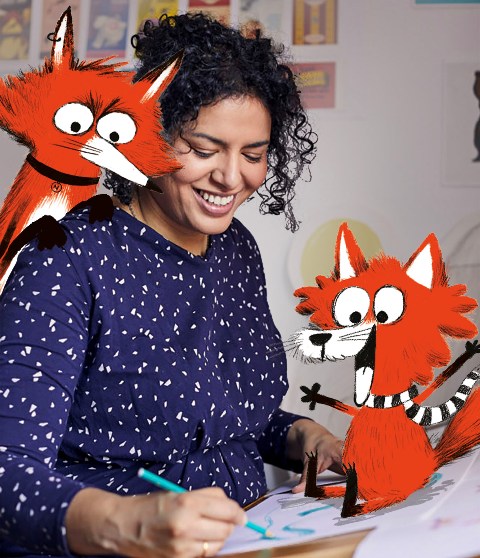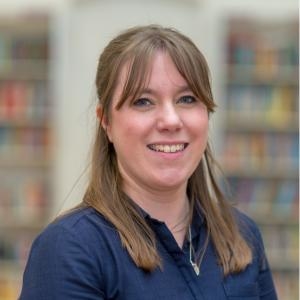
Authorgraph No.251: Nadia Shireen
Nadia Shireen’s deft ability to create compelling characters and engaging narratives in words and pictures has been apparent from the very start of her career. Her debut Good Little Wolf received a mention in the Bologna Ragazzi Opera Prima Award, and went on to win the UKLA Book Award. She’s been shortlisted for the Roald Dahl Funny Prize and the Waterstones Children’s Book Prize and, at the time of writing, her latest picturebook Barbara Throws a Wobbler has just been nominated for the Greenaway Medal 2022.
 She came to the world of picturebooks via a law degree and a career in journalism, most notably at teen favourite, Smash Hits. It was through being asked to create doodles for the front of the notebooks and Filofaxes given away as free gifts by the magazine that her childhood love of drawing returned to her, and led her to join the MA course in Children’s Book Illustration at Anglia Ruskin University, Cambridge.
She came to the world of picturebooks via a law degree and a career in journalism, most notably at teen favourite, Smash Hits. It was through being asked to create doodles for the front of the notebooks and Filofaxes given away as free gifts by the magazine that her childhood love of drawing returned to her, and led her to join the MA course in Children’s Book Illustration at Anglia Ruskin University, Cambridge.
Although her final piece for the MA was the work that became the successful Good Little Wolf, it wasn’t an easy journey. She found it difficult to see her playful way of illustrating amongst the observational drawings others on the course were doing. ‘I felt absolutely out of my depth’, she tells me, ‘I was one of maybe a dozen part-timers on the course. The full-timers terrified me because, whereas I was 30 and coming at this from a career in journalism, they had just done their degrees and had gone on to the MA. It seemed like they knew everything about art and I’d never gone to art school. No one had taught me about perspective. People would say things like, I love the quality of your line. And I remember actually saying to someone, “what does that mean?” I felt massively on the back foot for most of that MA.’
A pivotal moment came through illustrator and wood engraver John Lawrence, who saw the talent and passion that had inspired her to apply in the first place. ‘I remember him going through my sketchbook and looking at the doodles that I’d just been doing for me, when I was just watching TV; deranged animals and crazy characters. And he told me, “This is the stuff”’. He questioned why she was keeping these things separate from the course, making her reflect on the way she’d approached the work. ‘I’d just seen that as my naughty doodling, but he showed me that was what I was meant to do and that it was valid.’
She made the decision to take the last three months of the MA off from her job in journalism, and threw herself into the work around Good Little Wolf, in preparation for the final show. Her life changed, very suddenly from there. ‘I couldn’t believe what had happened. I’d spent the whole course just hoping to pass, then suddenly people wanted to publish my book. It was unbelievable.’
Her wonderfully wicked sense of humour pervades the book, and everything she’s published since. We discuss the ending of Good Little Wolf, a delightful twist on the tale, which provides surprise and delight to older readers who understand the fact that the story doesn’t end happily ever after. ‘That’s the magic of picture books, isn’t it?’ she explains, ‘It’s the text, the image and then there’s that magic bit that hopefully the reader does. You know when they’re ready to see it when they want to conjure up the ideas in their own imagination and try to work out what’s happened.’
Her characters and stories almost always start from an illustration. ‘It’s really old-fashioned in that I’ll start with just pen and paper, a really simple, subconscious doodling, trying to get my brain into a state of play. And while I’m playing, maybe someone will turn up, who I can ask questions to or who will be interesting enough to want to find out more about their story. Or maybe I’ll put someone next to them. So then that interaction becomes immediately interesting.’
 In every character, she tells me, there is always a small piece of herself, or her personality. This is particularly apparent in Billy, the star of Billy and the Beast, Billy and the Dragon and the upcoming Billy and the Pirates. ‘I’ve never been confident about my hair’, she explains, ‘I felt massively self-conscious about it. Still do really. I always wanted straight, lovely, easy hair, like the rest of my family. When I was drawing Billy, I thought that I wanted her to be me but braver. Me but more confident and completely physically confident. That’s so important for kids to see.’
In every character, she tells me, there is always a small piece of herself, or her personality. This is particularly apparent in Billy, the star of Billy and the Beast, Billy and the Dragon and the upcoming Billy and the Pirates. ‘I’ve never been confident about my hair’, she explains, ‘I felt massively self-conscious about it. Still do really. I always wanted straight, lovely, easy hair, like the rest of my family. When I was drawing Billy, I thought that I wanted her to be me but braver. Me but more confident and completely physically confident. That’s so important for kids to see.’
It’s her sense of playfulness, her ongoing connectedness to childhood and the innate understanding of children that shines through in her books. Every child will relate to being overwhelmed by their emotions and, in Barbara Throws a Wobbler, the story reflects this, offering children the chance to consider and empathise with the difficulties of self-regulation. ‘What I think we need to recognise, is that kids have emotions that are as valid and as big and as real as ours. I don’t know why collectively, we sort of diminish that. I don’t want to shy away from emotional truth. And I don’t think emotional truth is always straightforward.’
She took the task of telling Barbara’s story seriously, considering the care that would need to go into depicting her journey in a way that was both engaging, resonant and respectful. ‘When I was writing, I was very careful. When Barbara has her wobbler, it was very tempting to get her friends to come in or to get her parents to come and pick her up. I had to fight that and not let anybody else help her get out of there. Because this has to be helpful; it is about a child understanding their own big emotions, they’re the only one who’s going to be able to get themselves out of it. What if a kid is reading this, they don’t have any friends, or anybody to come and scoop them up? It had to be about her power. And that was a really challenging thing.’
Her latest book, Grimwood, is Shireen’s first foray into middle-grade fiction. It’s another hilariously funny but also deeply resonant tale, with friendship, family and belonging at its heart. ‘I was worried when I was writing it, it’d be too wacky,’ she reflects. ‘I wanted it to be really crazy and funny, but I want it to be a good story. And I wanted there to be heart and to put some real feeling in there. I feel warmly towards Ted and Nancy; they’re looking for a home, whether that home means a place or it means people or their parents. I feel quite attached to them and protective of them.’
The art direction, led by David McDougall, emphasises the two elements perfectly and takes Shireen back to what got her into illustration in the first place; the playfulness of her childhood drawings and the annotation and doodling of her days at Smash Hits. ‘What I really enjoyed was having the story laid out and then being able to go over it and draw all over it. We agreed it needed to look like you’ve got a copy of The Wind in the Willows from the library, and someone’s just ruined it!’
 The world of Grimwood is closely related to the landscapes she grew up in as a child; a mix of urban environment and countryside. But as with her characters, she was keen to instil a sense of reality in the setting. ‘As soon as I thought about the countryside, I very quickly related to my experience, going for a lovely country walk and then seeing an upturned shopping trolley, and I was poking fun at things. You know, we’ve got The Wind in the Willows and Winnie the Pooh, and it’s such an idealised, beautiful vision of the English countryside; absolutely idyllic and wonderful. But we don’t talk about the dead duck floating in the pond, or the Wellington boots or pile of tyres that someone’s set fire to. And that’s real. And that’s kind of funny.’
The world of Grimwood is closely related to the landscapes she grew up in as a child; a mix of urban environment and countryside. But as with her characters, she was keen to instil a sense of reality in the setting. ‘As soon as I thought about the countryside, I very quickly related to my experience, going for a lovely country walk and then seeing an upturned shopping trolley, and I was poking fun at things. You know, we’ve got The Wind in the Willows and Winnie the Pooh, and it’s such an idealised, beautiful vision of the English countryside; absolutely idyllic and wonderful. But we don’t talk about the dead duck floating in the pond, or the Wellington boots or pile of tyres that someone’s set fire to. And that’s real. And that’s kind of funny.’
With two more Grimwood stories to come, as well as the bonus of a World Book Day title in between, there’s plenty more to hook young readers in. And it’s her understanding of and responsibility towards her readers that spurs her on and keeps her focussed. ‘What I worry about is making sure that I can sustain the humour and the energy. I always want it to be rich, exciting and fun for the kids. The child, and making them laugh is always going to be my focus, because their time is precious. They could be on the iPad, or watching a movie; but the fact that they’re reading a book is amazing. And we want them to do more of that. So I take it quite seriously. I try not to take myself seriously. But I take that responsibility very seriously.’
 Charlotte Hacking is Central Learning Programmes Leader at CLPE. Prior to that she was a teacher and senior leader and taught across the primary years.
Charlotte Hacking is Central Learning Programmes Leader at CLPE. Prior to that she was a teacher and senior leader and taught across the primary years.
Grimwood, Simon and Schuster Children’s Books, 978-1471199301, £12.99 hbk
Barbara Throws a Wobbler, Jonathan Cape, 978-1780081366, £6.99 pbk
Good Little Wolf, Jonathan Cape, 978-1780080017, £6.99 pbk
Billy and the Beast, Jonathan Cape, 978-1780080680, £6.99 pbk




